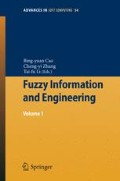Abstract
Fuzzy approaches are playing an important role in data mining. This paper in details analyses and compares the fuzzy clustering approaches based on the fuzzy equivalence relationthe fuzzy similarity relationthe fuzzy maximum tree and the optimized tree. According to the comparison, this paper gives a conclusion: the first three approaches referred are equal and the forth approach has the lowest degree of distortion, and finally verifies the conclusion by an instance.
Access this chapter
Tax calculation will be finalised at checkout
Purchases are for personal use only
Preview
Unable to display preview. Download preview PDF.
References
Klir, G.: Fuzzy Sets: An Overview of Fundamentals, Applications, and Personal Views. Beijing Normal University Press (2000)
Dunn, J.C.: Well-separated clusters and the optimal fuzzy partitions. J. Cybernet 4(1), 95–104 (1974)
Le, Z.: Fuzzy relation compositions and pattern recognition. Inf.Sci. 89, 107–130 (1996)
Tamra, S., et al.: Pattern classification based on fuzzy relations. IEEE Trans. SMC 1(1), 217–242 (1971)
Bezdek, J.C., Harris, J.O.: Convex decompositions of fuzzy partitions. JMAA 67, 490–512 (1979)
Esogbue, A.O.: Optimal clustering of fuzzy data via fuzzy dynamic programming. FSS 18, 283–298 (1986)
Auderberg, M.R.: Cluster Analysis for Applications. Academic Press, London
Xue-liang, Z., Zu-zeng, P.: On the Application of Fuzzy mathematical Approach to Flood Forest. In: Proceeding of International Symposium on Fuzzy Systems and Knowledge Engineering (1987)
Huang, Z.: Clustering Large Data Sets with Mixed Numeric and Categorical Values. In: Proceedings of The First Pacific-Asia Conference on Knowledge Discovery and Data Mining. World Scientific, Singapore (1997)
Author information
Authors and Affiliations
Editor information
Editors and Affiliations
Rights and permissions
Copyright information
© 2009 Springer-Verlag Berlin Heidelberg
About this paper
Cite this paper
Yang, Cd., Ren, Jj. (2009). The Comparison about the Clustering Analysis Based on the Fuzzy Relation. In: Cao, By., Zhang, Cy., Li, Tf. (eds) Fuzzy Information and Engineering. Advances in Soft Computing, vol 54. Springer, Berlin, Heidelberg. https://doi.org/10.1007/978-3-540-88914-4_56
Download citation
DOI: https://doi.org/10.1007/978-3-540-88914-4_56
Publisher Name: Springer, Berlin, Heidelberg
Print ISBN: 978-3-540-88913-7
Online ISBN: 978-3-540-88914-4
eBook Packages: EngineeringEngineering (R0)

